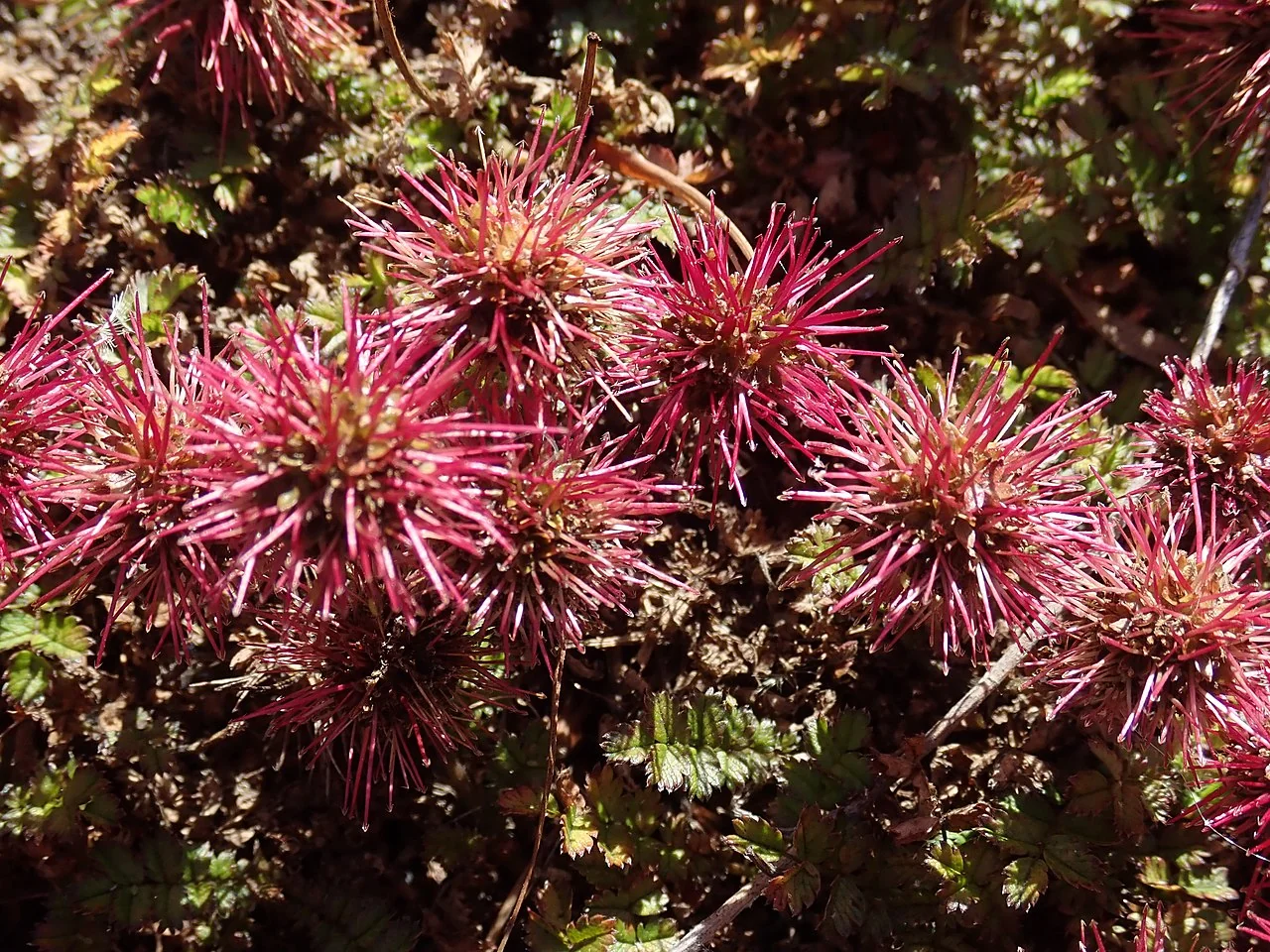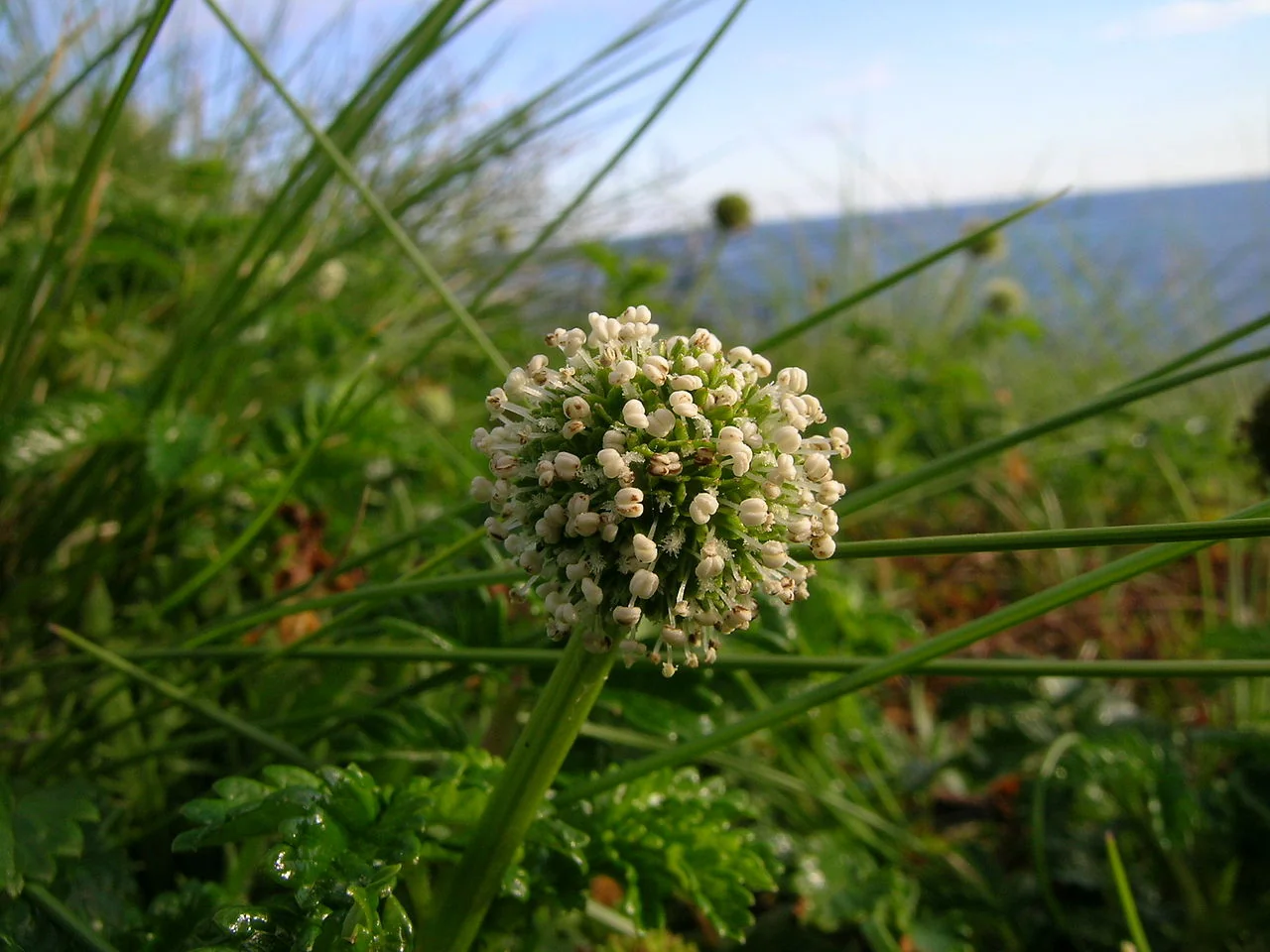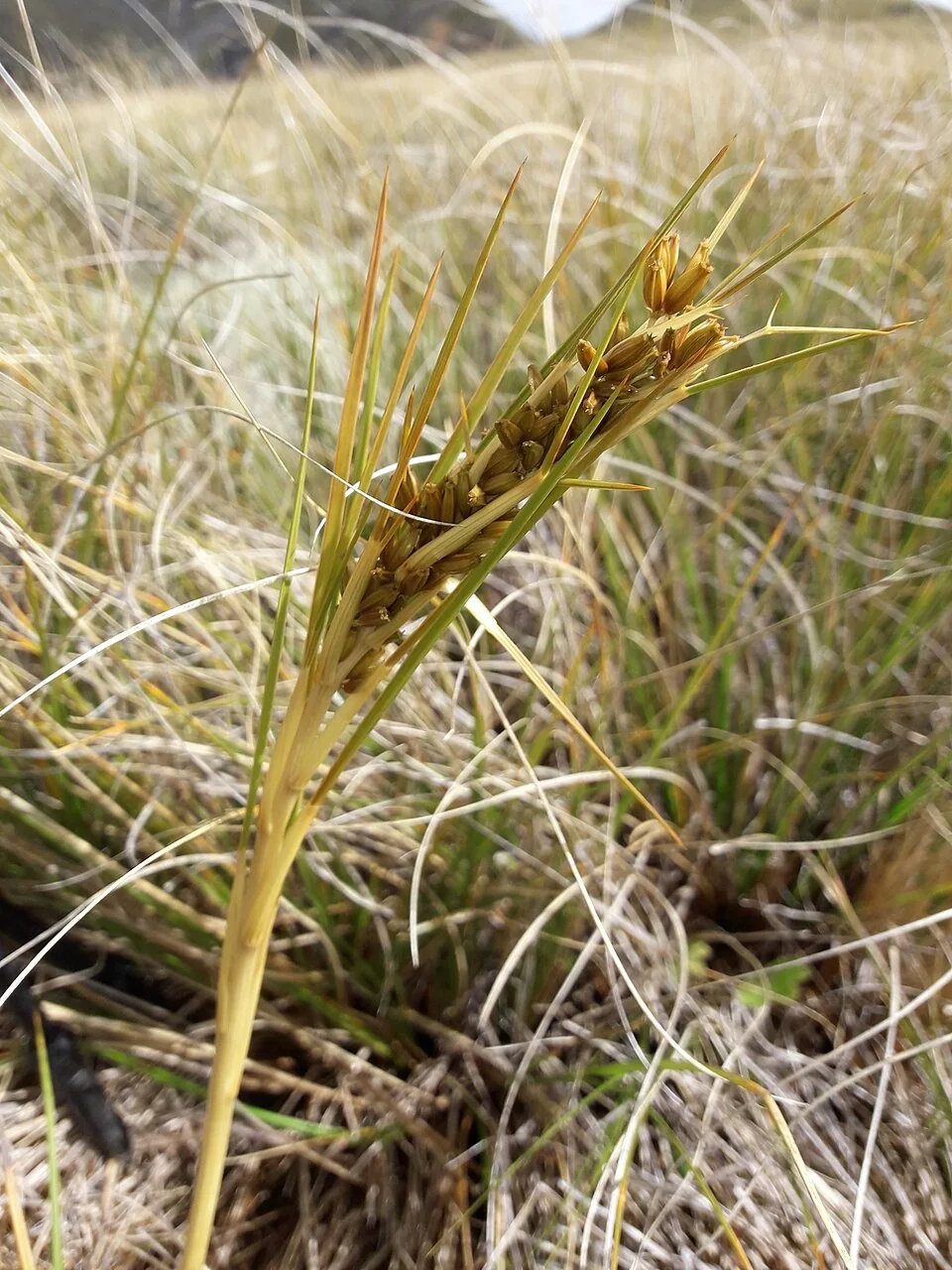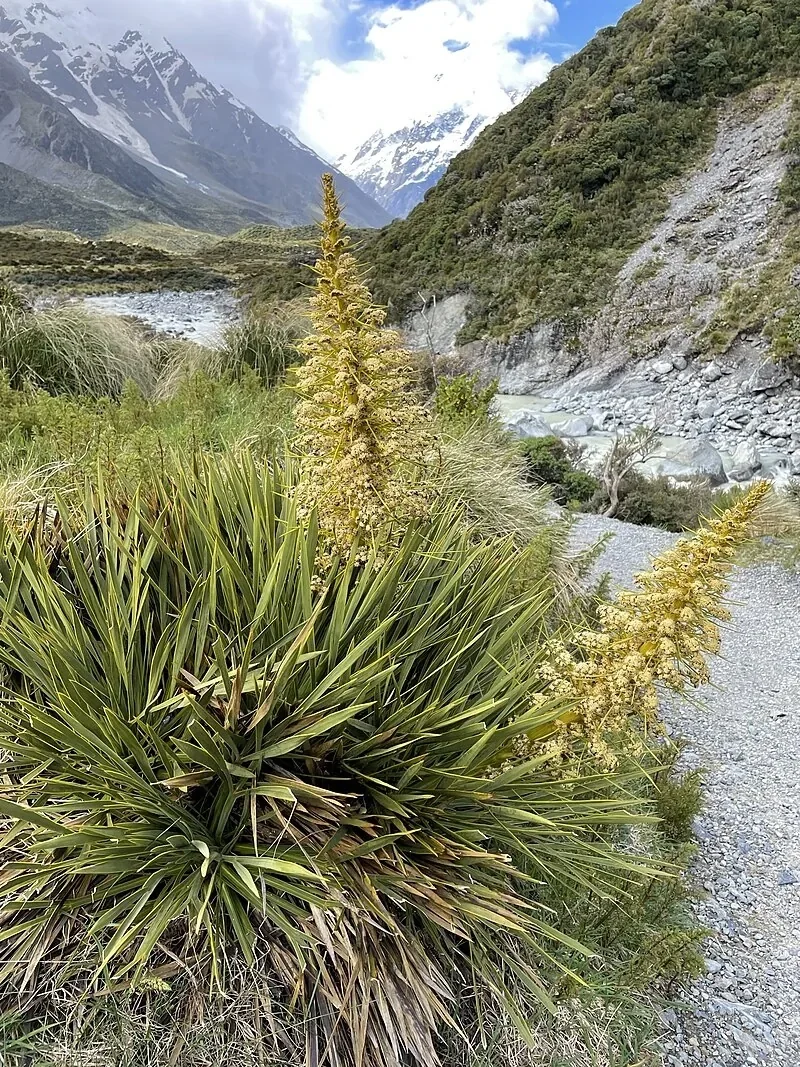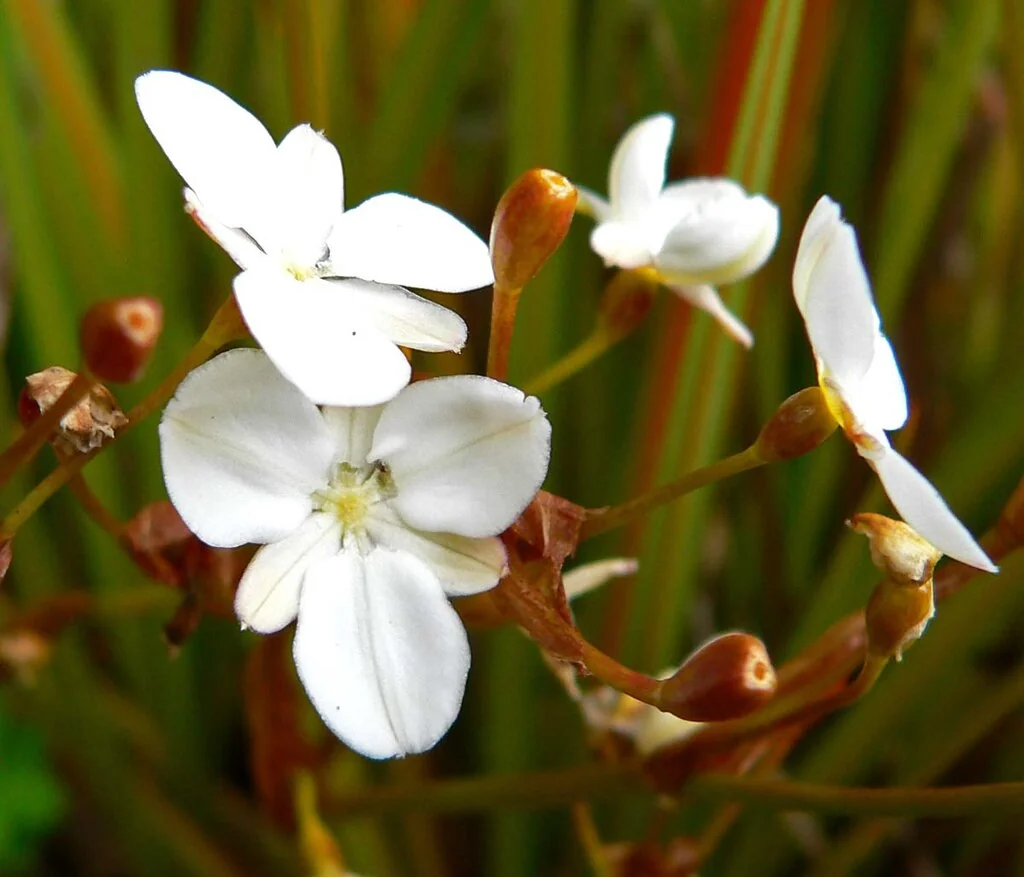
Orange New Zealand Iris
Libertia peregrinans
Orange New Zealand Iris ( Libertia peregrinans ), also known as Mīkoikoi, is a striking species among New Zealand's native grasses and flaxes celebrated for its vibrant, stiff, sword-like leaves that transition from green to a brilliant orange or deep copper, especially in sunny, open conditions. This hardy, clumping plant spreads via rhizomes to form dense patches, making it an excellent groundcover. In spring, it produces clusters of small, pure white, star-shaped flowers, which are followed by small, pear-shaped seed capsules. It is naturally found in coastal and wetland areas, often growing in sand dunes and on cliff faces, highlighting its tolerance for salt and wind. Its unique and colourful foliage provides year-round interest, making it a popular choice for modern gardens, mass plantings, and coastal landscapes.

Plant Description
Botanical Features
Orange New Zealand Iris ( Libertia peregrinans ) is a striking evergreen perennial herb native to New Zealand. It forms upright clumps of stiff, sword-like leaves that are typically orange-bronze, especially when exposed to full sun or stress, and can have green centers with bright orange margins. This vibrant coloration is often described as "ever-orange" and is particularly attractive when backlit. It spreads slowly by short rhizomes, forming colonies or low, spreading clumps. Small, white, star-like or bowl-shaped flowers, about 10-30 mm in diameter, emerge on short stalks or branched stems during spring and summer. These flowers are followed by decorative seed capsules that ripen from green to orange, yellow, or black, containing bright tangerine-orange, subglobose seeds. It is found in coastal to lowland areas, including coastal scrub, beaches, dune systems, estuaries, river mouths, dune swales, bogs, and swamp margins.
Quick Facts
| Scientific Name | Libertia Peregrinans |
|---|---|
| Common Name | Orange New Zealand Iris, Mīkoikoi |
| Family | Iridaceae |
| Height | Up to 60 cm |
| Spread | Spreading, up to 1 m wide |
| Light | Full sun to partial shade |
| Soil | Moist, well-drained soils |
| Water Needs | Moderate |
| Frost Tolerance | Moderate |
| Salt Tolerance | High |
| Growth Rate | Medium to fast |
| Lifespan | Perennial |
Climate Best Suited to
Orange New Zealand Iris ( Libertia peregrinans ) is native to New Zealand, typically found in coastal areas, wetlands, and open grasslands. It thrives in mild, temperate climates with consistent rainfall and moderate temperatures. It is reasonably tolerant of wind and salt spray, making it suitable for coastal gardens, but prefers sheltered locations away from extreme exposure. Its natural habitat includes damp areas and open sites, indicating a preference for good light but with some protection. It can be successfully cultivated in similar temperate regions, provided it has good drainage and protection from extreme heat or prolonged severe frosts when young.
Regional Suitability
| Whangārei | Ideal |
| Auckland | Ideal |
| Hamilton | Suitable |
| Rotorua | Suitable |
| Tauranga | Ideal |
| Gisborne | Ideal |
| New Plymouth | Ideal |
| Whanganui | Ideal |
| Palmerston North | Suitable |
| Napier | Ideal |
| Wellington | Ideal |
| Nelson | Ideal |
| Christchurch | Suitable |
| Dunedin | Suitable |
| Invercargill | Suitable |
| City | Climate Suitability |
|---|
Natural Habitat
Typical Environments
Understand the natural habitat of Orange New Zealand Iris ( Libertia peregrinans ), which is found throughout New Zealand, in coastal areas, wetlands, and open grasslands. This section details its geographical distribution, preferred environmental conditions, and the types of ecosystems where it naturally occurs.
- Widespread across New Zealand, from sea level to moderate altitudes.
- Found in coastal areas, wetlands, and open grasslands.
- Prefers moist, well-drained sites with good air circulation.
- Thrives in full sun to partial shade.
Its broad habitat range highlights its adaptability and resilience, making it a fascinating subject for ecological study.
Plant Conservation
Libertia peregrinans , commonly known as the Orange New Zealand Iris or mīkoikoi, is a plant species endemic to New Zealand, found across the North, South, Stewart, and Chatham Islands. It is currently classified as "Threatened - Nationally Vulnerable" under the New Zealand Threat Classification System, a status it has held since at least 2012, following an earlier classification of "Gradual Decline" in 2004. This distinctive plant typically inhabits coastal and lowland areas, thriving in sandy, peaty, or pumiceous soils, including dune slacks, swamp margins, and poorly draining ground under scrub. Its decline is primarily attributed to widespread habitat loss and modification due to coastal development, encroachment by weeds, and browsing by livestock (cattle, sheep, horses) and rabbits. Over-collection by people has also contributed to its vulnerability. Conservation efforts for Libertia peregrinans focus on habitat protection and restoration, invasive species management, population management (surveying, marking sites, excluding stock), propagation and re-establishment, and monitoring and awareness. Libertia peregrinans also contributes to the ecosystem by supporting native coastal invertebrate communities and preserving the genetic diversity of endemic iris species.
Growing Requirements
Soil Requirements
Orange New Zealand Iris thrives in moist, well-drained soils. It is adaptable to a range of soil types, including sandy, loamy, and even some clay soils, but good drainage is crucial to prevent root rot. Incorporating organic matter can improve soil structure and moisture retention. A neutral to slightly acidic pH is generally preferred.
- Prefers moist, well-drained soils.
- Adaptable to sandy or loamy soil types.
- Good drainage is essential.
- Neutral to slightly acidic pH preferred.
Light Requirements
Orange New Zealand Iris performs best in full sun to partial shade. In full sun, its orange-copper foliage will develop the most intense colour. In partial shade, the foliage may be greener but will still thrive. Ensure it receives adequate light for healthy growth and flowering.
- Full sun to partial shade.
- More intense foliage colour in full sun.
- Adaptable to various light conditions.
Water Requirements
Orange New Zealand Iris requires moderate watering, especially during dry periods and its establishment phase. Once established, it is reasonably drought-tolerant but will benefit from occasional deep watering during prolonged dry spells. Ensure the soil is consistently moist but not waterlogged.
- Moderate watering needs.
- Drought-tolerant once established.
- Avoid waterlogging.
Planting Guide
Best Time to Plant
The best time to plant Orange New Zealand Iris is during autumn or spring, when temperatures are mild and rainfall is more consistent. This allows the plant to establish its root system before the extremes of summer heat or winter cold.
Choosing a Location
Select a site with full sun to partial shade and moist, well-drained soil. Orange New Zealand Iris is ideal for borders, mass plantings, rock gardens, or along the edges of ponds and streams. Ensure it has good air circulation and is protected from strong, persistent winds if in an exposed location.
Planting Steps
- Dig a hole twice the width of the root ball and the same depth.
- Gently remove the plant from its container, being careful not to disturb the roots.
- Place the plant in the hole, ensuring the top of the root ball is level with the surrounding soil.
- Backfill with amended soil, firming gently around the base of the plant.
- Water thoroughly immediately after planting to settle the soil.
- Apply a light layer of organic mulch to help retain moisture and suppress weeds, keeping it away from the crown.
Initial Care
Water regularly during the first 6-12 months to help establish a strong root system. Once established, Orange New Zealand Iris is reasonably low maintenance and requires less frequent watering. Protect young plants from extreme conditions if necessary.
Ecological Role
Ecosystem Roles
The ecological importance of Orange New Zealand Iris ( Libertia peregrinans ) within its native New Zealand ecosystems is significant. Its flowers provide nectar for native insects, and its seeds may be a food source for small birds, contributing to the local food web and aiding in seed dispersal across diverse habitats.
- Flowers provide nectar for native insects.
- Seeds may be a food source for native birds.
- Contributes to biodiversity in diverse ecosystems.
As an endemic species, it is an integral part of the unique biodiversity that has evolved in New Zealand, supporting the delicate balance of its natural habitats.
Uses and Significance
Garden Uses
- Excellent for borders, mass plantings, and rock gardens.
- Suitable for coastal gardens due to its salt tolerance.
- Provides year-round interest with evergreen, colourful foliage.
- Attracts pollinators, such as bees, to its flowers.
Cultural Significance
Traditional Uses and Values
Libertia peregrinans , also known as the orange New Zealand iris or mīkoikoi, holds cultural significance primarily within Māori tradition. The plant is recognized by various Māori names, including mīkoikoi, tūrutu, tūkāuki, and mānga-a-huripapa, which indicates its widespread recognition across different tribal regions.
Although not extensively used in traditional medicine or crafts, Libertia peregrinans was valued as part of New Zealand's natural heritage. Its presence in traditional landscapes reflects its role in Māori environmental knowledge systems. In contemporary times, it is increasingly incorporated into marae gardens and eco-restoration projects, signifying its ongoing importance in cultural restoration practices.
Landscaping Applications
Orange New Zealand Iris ( Libertia peregrinans ) is a highly versatile and attractive plant for various landscaping applications, particularly in native and low-maintenance gardens. Its vibrant foliage and delicate flowers make it a valuable asset.
- Ideal for borders, mass plantings, and rock gardens.
- Excellent for coastal gardens due to its salt tolerance.
- Provides year-round interest with evergreen, colourful foliage.
- Suitable for planting along the edges of ponds and streams.
Its ability to thrive in challenging conditions and its aesthetic appeal make it a popular choice for creating resilient and beautiful native landscapes.
Seasonal Care Calendar
Spring
New growth emerges, and delicate white flowers appear. This is an ideal time for planting new Orange New Zealand Iris specimens or propagating from division. Ensure consistent moisture for young plants and protect them from strong winds if necessary. A light feed with a balanced slow-release fertilizer can encourage vigorous growth.
- Ideal time for planting and propagation.
- Ensure consistent moisture for new plants.
- Light fertilization if needed.
Summer
Orange New Zealand Iris is actively growing and flowering during summer. Consistent watering is crucial, especially during dry spells, to prevent stress. Monitor for pests and diseases, though it is generally quite resilient.
- Active growth and flowering.
- Consistent watering is essential.
- Monitor for pests and diseases.
Autumn
Growth slows as temperatures cool. This is another good time for planting, allowing roots to establish before winter. Minimal care is required for established plants, but ensure they remain adequately hydrated.
- Good time for planting.
- Minimal care for established plants.
- Ensure adequate hydration.
Winter
Orange New Zealand Iris is evergreen and provides year-round interest. It is moderately frost-tolerant and requires minimal care during this period. Ensure good drainage to prevent root issues in wet conditions.
- Evergreen, provides year-round interest.
- Protect young plants from severe frost.
- Ensure good drainage.
When to Prune and How Much
Orange New Zealand Iris generally requires minimal pruning. The primary reason for pruning is to remove spent flower stalks and old, damaged, or discoloured foliage to maintain the plant's appearance and health. Its natural clumping habit is often quite attractive, so extensive pruning is rarely needed.
- Remove spent flower stalks as needed.
- Remove old, damaged, or discoloured foliage.
- Best done in late winter or early spring before new growth.
- Use clean, sharp tools.
Avoid heavy pruning, as this can stress the plant. Allow it to develop its natural, graceful form.
How to Grow Orange New Zealand Iris
Orange New Zealand Iris, also known as Mīkoikoi, is a striking native perennial celebrated for its vibrant, stiff, sword-like leaves that transition from green to a brilliant orange or deep copper. This hardy, clumping plant spreads via rhizomes to form dense patches, making it an excellent groundcover. In spring, it produces clusters of small, pure white, star-shaped flowers, which are followed by small, pear-shaped seed capsules. Its unique and colourful foliage provides year-round interest, making it a popular choice for modern gardens, mass plantings, and coastal landscapes. Understanding its propagation methods is key to successfully growing this beautiful species.
From Seed
Propagating Orange New Zealand Iris from fresh seed is a viable method, though germination can be slow and may require stratification. Collect ripe seeds in late summer or early autumn. Clean the seeds thoroughly to remove any fleshy pulp. Sow the seeds in a tray filled with a well-draining seed-raising mix, lightly covering them. The seeds typically require a period of cold stratification (e.g., refrigerate for 2-3 months) to break dormancy. Maintain consistent moisture in the seed tray and keep it in a warm, sheltered location. Germination can take several weeks to months after stratification. Once seedlings have developed a few true leaves, they can be potted into individual containers and grown in a sheltered environment before planting out. Note that plants grown from seed may show some variation from the parent plant.
From Division
Division of established clumps is the easiest and most reliable method for propagating Orange New Zealand Iris. This is best done in spring or autumn. Carefully dig up a mature clump and gently separate it into smaller sections, ensuring each section has a healthy portion of roots and some foliage. Replant the divisions immediately into well-prepared soil that is moist, well-drained, and humus-rich. Water thoroughly after planting and keep consistently moist until new growth appears. This method is excellent for quickly expanding your stock of plants and for rejuvenating older, less vigorous clumps.
Pests and Diseases
Orange New Zealand Iris is generally a robust plant and resistant to most pests and diseases. Its adaptation to diverse environments means it has few significant natural enemies.
Common Pests
- Generally pest-free.
- Occasionally, aphids or slugs may appear on new growth, but rarely cause significant damage.
Common Diseases
- Highly resistant to diseases.
- Root rot can occur in poorly drained, waterlogged soils.
- Leaf spot diseases are rare but can occur in very humid conditions.
Good garden hygiene, proper watering, and excellent drainage are key to preventing most pest and disease issues. Healthy, well-sited plants are rarely affected by significant problems.
Bonus Tip
Expert Growing Advice
The name "peregrinans" means "wandering" or "travelling", which refers to the way this plant spreads by its rhizomes to form extensive colonies. This makes it an excellent plant for filling in gaps and creating a dense, colourful groundcover.




